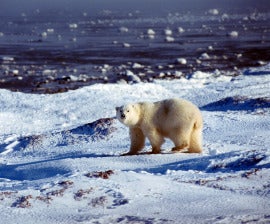-

Polar bears face numerous threats. Alain Pons/Photo Alto
Canada holds more than half the world’s population of polar bears, most ranging either solely or partially within the vast borders of Nunavut, a territory spanning nearly 2 million square kilometers. These ice-dependent bears—beloved by people worldwide—have become a symbol of wilderness species most vulnerable to the threats of global climate change.
New research confirms that sea ice in the Arctic is declining rapidly and scientists believe that continued melting will have devastating effects for the long-term survival of polar bears; this is not to mention polar bears’ sensitivity to other human disturbances, such as toxic pollution and oil and gas development in the north.
But these are not the animals’ only challenges to survival. Trophy hunters have also set their sights on Canada’s polar bears. Inuit hunters in Nunavut are allowed to kill polar bears for subsistence, but they have the right to sell their subsistence tags to foreign sport hunters. Years ago, this opened the door for trophy hunters—mostly from the United States—to offer large cash payments for the “privilege” of killing polar bears.
Profit or protection?
In 2005, the government of Nunavut announced a controversial plan to increase hunting quotas for polar bears by as much as 28 percent. The increase—which was based solely on local reports that more bears are being seen near villages—put even more pressure on a species already vulnerable to extinction because of climate change, environmental contaminants, and a long history of being hunted for sport. While the government has since reduced the quota, trophy hunting of polar bears continues. Wealthy trophy hunters pay native guides $25,000 to $40,000 for the chance to kill the bears. The high demand for polar bear hunting permits is one reason scientists are skeptical of local polar bear population increase reports, especially given that these reports have been known to be unjustifiably inflated when the demand for trophies is high. Furthermore, Canadian polar bear researchers explain that seeing more polar bears near villages is not necessarily evidence of a population increase. They note that the increased sightings are more likely the result of melting ice (due to global climate change), which is forcing polar bears inland.
Studies have shown that polar bears rely on high adult survival to maintain population numbers, suggesting that the bears have not evolved to withstand high losses to their adult population. This means that trophy hunting can pose a significant conservation threat, in that the hunters are specifically targeting adults.
An uncertain future
The World Conservation Union (IUCN), the internationally respected authority on endangered species, recognizes the polar bear as a vulnerable species, meaning they are in danger of becoming extinct. In May of 2008, the United States government added polar bears to their endangered species list and imposed a ban on imports of polar bear parts. Since most hunters targeting polar bears in Canada have come from the United States, this ban deals a serious blow to the polar bear trophy hunting industry and has eased some of the pressure imposed on these bears. However, the real power to save polar bears lies with the Canadian government who has, up to now, shown a complete disregard for the welfare of these bears. In 2002, Canada’s expert committee on endangered species recommended for the third time that polar bears be added to Canada’s species at-risk list—but Canadian politicians ignored their advice. In 2008, this expert committee again reiterated its recommendation, but the Canadian government again failed to offer protection to these majestic, yet vulnerable creatures. It is time for the Canadian government to start paying attention to scientific evidence and take serious steps toward protecting polar bears and their habitat before it is too late.
